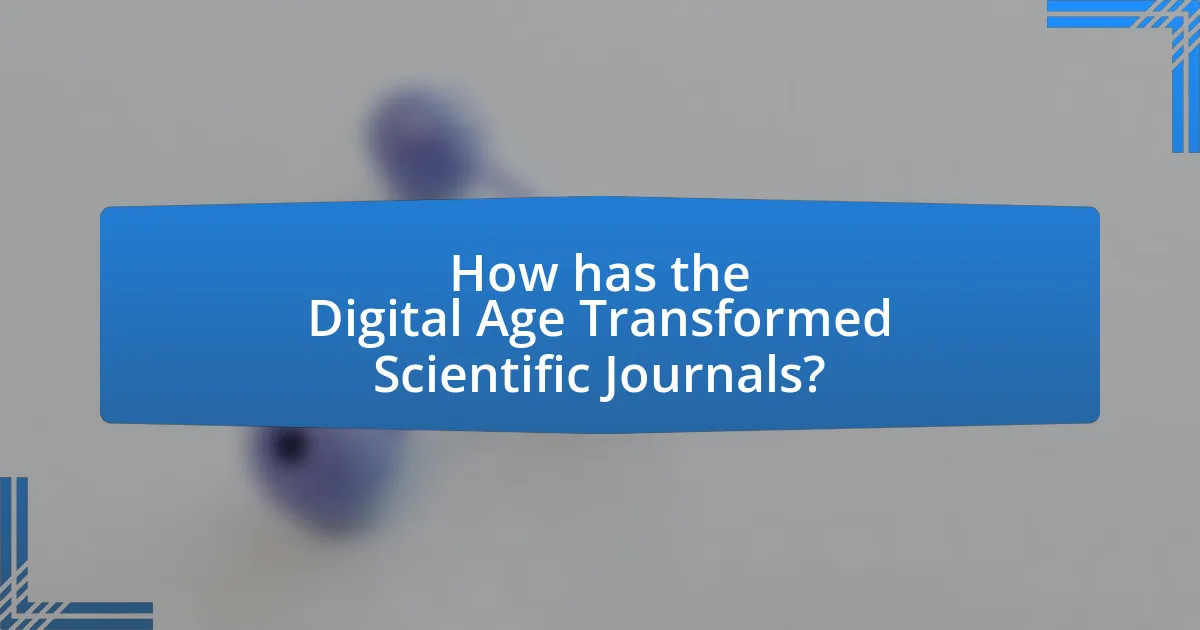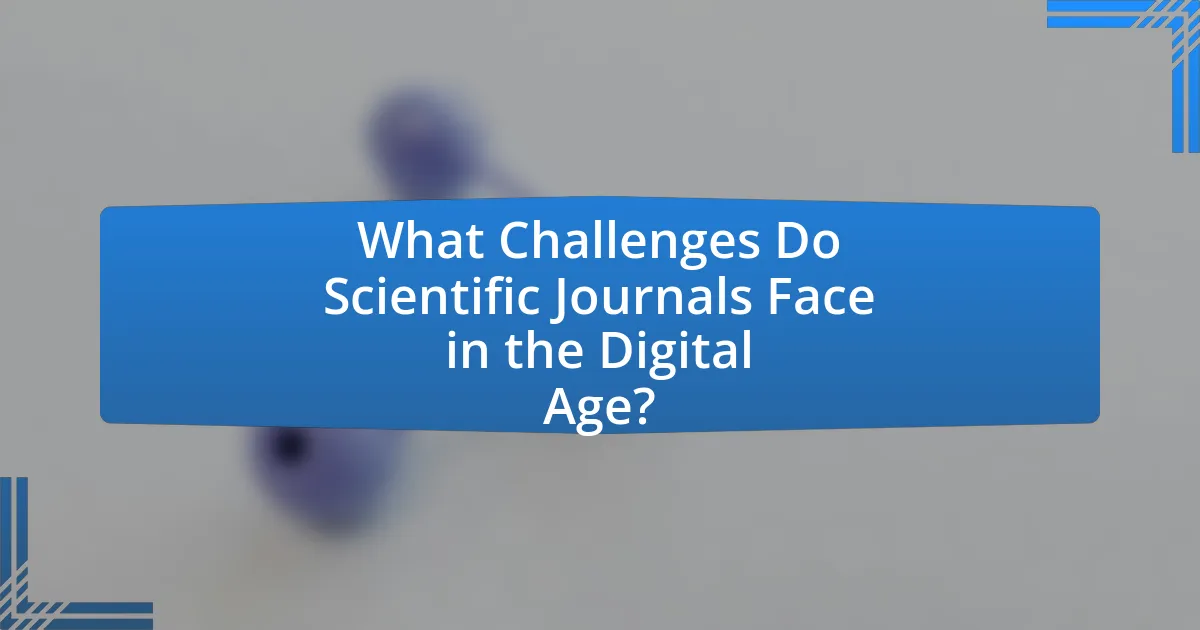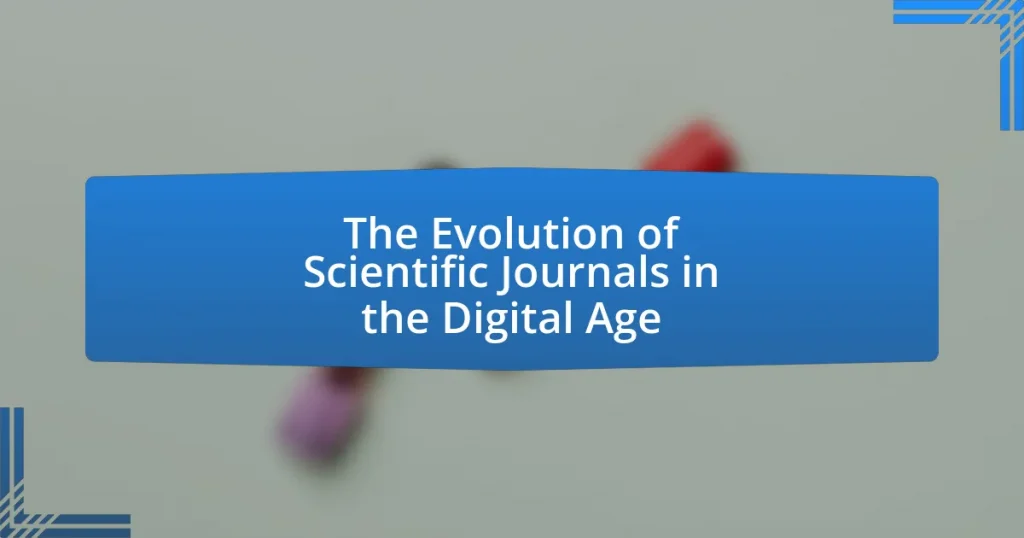Scientific journals are essential periodicals that publish scholarly articles, including original research, reviews, and theoretical discussions across various scientific fields. This article examines the evolution of scientific journals from their inception in the 17th century to their current digital formats, highlighting key milestones such as the establishment of peer review processes and the rise of open access models. It also addresses the significance of peer review in maintaining research quality, the challenges faced by journals in the digital age, and the impact of technology on publishing practices. Furthermore, the article explores future trends in scientific publishing, emphasizing the importance of data sharing and collaboration for advancing scientific knowledge.

What are Scientific Journals and Their Role in Research?
Scientific journals are periodicals that publish scholarly articles, primarily reporting original research findings, reviews, and theoretical discussions in various fields of science. Their role in research is crucial as they serve as a platform for disseminating knowledge, facilitating peer review, and ensuring the integrity and quality of scientific communication. For instance, the peer review process, which involves evaluation by experts in the field, helps validate research before publication, thereby maintaining high standards in scientific literature. According to the Directory of Open Access Journals, there are over 15,000 peer-reviewed journals globally, highlighting their significance in the academic community for sharing and advancing scientific knowledge.
How have scientific journals evolved over time?
Scientific journals have evolved significantly from their inception in the 17th century to the present digital age. Initially, they served as platforms for disseminating scientific knowledge among a small community of scholars, with the first journal, “Philosophical Transactions,” published by the Royal Society in 1665, focusing on sharing findings in a structured format. Over time, the number of journals increased, and the peer-review process became standardized in the 20th century, enhancing the credibility and quality of published research.
With the advent of the internet in the late 20th century, scientific journals transitioned to digital formats, allowing for broader access and faster dissemination of research findings. Open access models emerged, enabling researchers to publish their work without subscription barriers, thus democratizing access to scientific knowledge. According to a 2021 report by the International Association of Scientific, Technical and Medical Publishers, over 50% of all scholarly articles are now published in open access journals, reflecting this shift towards accessibility.
Furthermore, advancements in technology have introduced new formats for publishing, such as preprints and multimedia content, which facilitate rapid sharing and collaboration among researchers. This evolution highlights the ongoing transformation of scientific journals in response to technological advancements and the changing needs of the global research community.
What were the key milestones in the history of scientific journals?
The key milestones in the history of scientific journals include the establishment of the first journal, “Philosophical Transactions of the Royal Society,” in 1665, which marked the beginning of formal scientific communication. In the 18th century, the proliferation of journals increased, with notable publications like “Journal des Sçavans” in France. The 19th century saw the introduction of peer review processes, enhancing the credibility of published research. The advent of electronic journals in the late 20th century revolutionized access to scientific literature, leading to the rise of open access models in the 21st century, which democratized information dissemination. These milestones collectively reflect the evolution of scientific journals from print to digital formats, significantly impacting how research is shared and accessed globally.
How did the print era shape the development of scientific journals?
The print era significantly shaped the development of scientific journals by establishing a formalized medium for disseminating research findings. During the 17th century, the advent of the printing press allowed for the mass production of written works, leading to the first scientific journals, such as “Philosophical Transactions” of the Royal Society in 1665. This innovation enabled researchers to share their discoveries with a broader audience, fostering collaboration and peer review, which became essential components of scientific communication. The print format also standardized the presentation of research, including structured abstracts, methodologies, and references, which are now foundational elements of scientific journals.
What is the significance of peer review in scientific journals?
Peer review is significant in scientific journals because it ensures the quality and credibility of published research. This process involves experts evaluating a manuscript for its validity, significance, and originality before publication, which helps to identify errors, biases, and methodological flaws. Studies have shown that peer-reviewed articles are more likely to be reliable and influential in advancing knowledge, as evidenced by the higher citation rates of peer-reviewed work compared to non-peer-reviewed sources. Additionally, peer review fosters a culture of accountability and transparency in research, contributing to the integrity of the scientific community.
How does the peer review process work?
The peer review process involves the evaluation of a manuscript by experts in the same field before publication in a scientific journal. Initially, the author submits the manuscript to the journal, where the editor assesses its suitability. If deemed appropriate, the editor sends the manuscript to several reviewers who provide feedback on the quality, validity, and originality of the research. Reviewers typically have expertise in the subject matter and are selected based on their knowledge and experience. After reviewing, they submit their comments and recommendations to the editor, who makes the final decision regarding publication, revision, or rejection. This process ensures that published research meets the standards of the scientific community, enhancing the credibility and reliability of scientific literature.
Why is peer review important for maintaining research quality?
Peer review is crucial for maintaining research quality because it ensures that studies are evaluated by experts in the field before publication. This process helps identify flaws in methodology, data interpretation, and overall validity, thereby enhancing the credibility of the research. Studies have shown that peer-reviewed articles are more likely to be reliable and impactful, as they undergo rigorous scrutiny that filters out unsubstantiated claims and errors. For instance, a 2019 analysis published in the journal “PLOS ONE” found that peer-reviewed research is associated with higher citation rates, indicating greater acceptance and trust within the scientific community.

How has the Digital Age Transformed Scientific Journals?
The Digital Age has transformed scientific journals by enabling open access, enhancing dissemination speed, and facilitating data sharing. Open access models have increased the availability of research to a broader audience, allowing for greater public engagement and collaboration. The speed of publication has significantly improved, with online platforms allowing for rapid peer review and immediate dissemination of findings, as evidenced by the rise of preprint servers like arXiv and bioRxiv. Additionally, digital tools have made it easier for researchers to share datasets and supplementary materials, fostering transparency and reproducibility in research. These changes have collectively reshaped the landscape of scientific communication, making it more inclusive and efficient.
What are the main changes brought by digital publishing?
Digital publishing has fundamentally transformed the landscape of scientific journals by enhancing accessibility, reducing publication costs, and accelerating the dissemination of research. These changes allow researchers and the public to access a vast array of scientific literature online, often for free, which contrasts sharply with traditional print models that limited availability. For instance, a study by the Pew Research Center in 2016 indicated that 87% of researchers reported that digital platforms improved their ability to share and access research findings. Additionally, digital publishing has streamlined the peer review process, enabling faster publication times, which is critical in rapidly evolving fields. This shift has led to an increase in the volume of published research, with the number of scholarly articles growing exponentially; for example, the number of articles indexed in PubMed increased from approximately 500,000 in 2000 to over 1.5 million by 2020.
How has accessibility to research changed with digital journals?
Accessibility to research has significantly improved with the advent of digital journals. Digital journals provide immediate online access to a vast array of research articles, eliminating geographical and financial barriers that often restricted access to printed materials. According to a 2020 study published in the journal “PLOS ONE,” the shift to digital formats has increased the visibility and dissemination of research, with open-access journals experiencing a 50% increase in readership compared to traditional subscription-based models. This transformation allows researchers, students, and the general public to access scientific knowledge more easily, fostering greater collaboration and innovation in various fields.
What impact has the internet had on the dissemination of scientific knowledge?
The internet has significantly enhanced the dissemination of scientific knowledge by enabling rapid access and sharing of research findings globally. This transformation is evidenced by the rise of open-access journals, which allow researchers to publish their work without subscription barriers, thus increasing visibility and citation rates. For instance, a study published in PLOS Biology found that articles in open-access journals are cited 18% more than those in traditional subscription-based journals, demonstrating the internet’s role in amplifying the reach and impact of scientific research. Additionally, platforms like ResearchGate and Google Scholar facilitate networking among scientists, further accelerating the exchange of ideas and collaboration across disciplines.
How have digital platforms influenced the peer review process?
Digital platforms have significantly streamlined the peer review process by enhancing accessibility, efficiency, and transparency. These platforms allow for faster submission and review cycles, enabling researchers to share their work with a global audience and receive feedback more quickly. For instance, platforms like PubPeer and ResearchGate facilitate post-publication peer review, allowing for ongoing critique and discussion of published research. Additionally, digital tools such as automated tracking systems and online collaboration features have reduced the administrative burden on editors and reviewers, leading to quicker turnaround times. A study published in the journal “Nature” highlighted that the average time for peer review has decreased by approximately 30% since the adoption of digital platforms, demonstrating their impact on the overall efficiency of the process.
What are the advantages and disadvantages of online peer review?
Online peer review offers several advantages and disadvantages. The primary advantage is increased accessibility, allowing a broader range of experts to participate in the review process, which can enhance the quality and diversity of feedback. A study published in the journal “PLOS ONE” found that online peer review can expedite the review process, reducing the time from submission to publication. Conversely, a significant disadvantage is the potential for bias and lack of accountability, as anonymity can lead to unconstructive criticism or conflicts of interest. Research from the “Journal of Scholarly Publishing” highlights that online platforms may also struggle with ensuring the integrity of the review process, as the ease of submission can lead to an influx of lower-quality manuscripts.
How do open access models affect the peer review system?
Open access models significantly impact the peer review system by increasing accessibility and transparency in the publication process. These models allow researchers to share their findings without subscription barriers, which can lead to a broader range of submissions and a more diverse pool of peer reviewers. For instance, studies have shown that open access journals often implement rigorous peer review processes similar to traditional journals, ensuring quality while promoting faster dissemination of research. Additionally, the transparency of open access can enhance accountability among reviewers, as their contributions are often publicly acknowledged, fostering a culture of collaboration and constructive feedback.

What Challenges Do Scientific Journals Face in the Digital Age?
Scientific journals face several challenges in the digital age, including issues related to accessibility, peer review integrity, and financial sustainability. Accessibility is a significant concern, as many journals operate under subscription models that limit public access to research findings, hindering the dissemination of knowledge. Peer review integrity is also at risk due to the rise of predatory journals, which compromise the quality of published research by bypassing rigorous review processes. Additionally, financial sustainability poses a challenge, as traditional funding models are disrupted by the shift to open access, requiring journals to adapt to new revenue streams while maintaining quality. These challenges are underscored by the increasing demand for transparency and rapid publication in the scientific community.
What are the issues related to publication ethics?
Issues related to publication ethics include plagiarism, data fabrication, authorship disputes, and conflicts of interest. Plagiarism involves using another’s work without proper attribution, undermining the integrity of research. Data fabrication refers to the manipulation or invention of research data, which can lead to false conclusions and harm the scientific community. Authorship disputes arise when individuals disagree on who should be credited for a publication, often leading to ethical dilemmas regarding contributions. Conflicts of interest occur when personal or financial interests may compromise the objectivity of research, potentially influencing the outcomes and interpretations of studies. These issues threaten the credibility of scientific literature and the trust of the public in research findings.
How do predatory journals affect the credibility of scientific publishing?
Predatory journals significantly undermine the credibility of scientific publishing by disseminating unverified and often misleading research. These journals typically lack rigorous peer review processes, allowing substandard studies to be published, which can misinform the scientific community and the public. A study by Beall (2016) identified over 1,000 predatory journals that exploit the open-access model, charging authors fees without providing legitimate editorial services. This proliferation of low-quality research can lead to a dilution of trust in legitimate scientific findings, as stakeholders struggle to differentiate between credible sources and those that are not.
What measures can be taken to combat unethical publishing practices?
To combat unethical publishing practices, implementing strict ethical guidelines and transparency in the peer review process is essential. Establishing clear standards for authorship, conflict of interest disclosures, and the integrity of data reporting can significantly reduce instances of misconduct. For instance, the Committee on Publication Ethics (COPE) provides a framework that journals can adopt to ensure ethical compliance, which has been shown to improve accountability in publishing. Additionally, promoting awareness and education about ethical standards among researchers and editors can further deter unethical behavior, as evidenced by initiatives from organizations like the International Committee of Medical Journal Editors (ICMJE).
How is the financial model of scientific journals changing?
The financial model of scientific journals is shifting from subscription-based revenue to open access funding. This change is driven by the increasing demand for publicly accessible research, leading many journals to adopt article processing charges (APCs) that authors or their institutions pay to publish their work. According to a report by the International Association of Scientific, Technical and Medical Publishers, the open access market grew to $1.5 billion in 2020, indicating a significant transition in funding mechanisms. This evolution reflects a broader trend towards transparency and accessibility in scientific communication.
What are the implications of subscription-based versus open access models?
Subscription-based models restrict access to research articles to individuals or institutions that pay for subscriptions, which can limit the dissemination of knowledge and create barriers for researchers in low-income settings. In contrast, open access models allow free access to research articles, promoting wider distribution and potentially increasing citation rates, as evidenced by a study published in PLOS ONE, which found that open access articles are cited 18% more than subscription-based articles. The implications of these models affect not only the accessibility of research but also the funding mechanisms for journals, the sustainability of publishing practices, and the overall impact on scientific communication in the digital age.
How do funding sources influence journal operations and research accessibility?
Funding sources significantly influence journal operations and research accessibility by determining the financial viability and publication model of the journals. For instance, journals funded by institutions or government grants may prioritize open access, making research freely available to the public, which enhances accessibility. In contrast, journals reliant on subscription fees may limit access to those who can afford it, thereby restricting the dissemination of knowledge. A study by the European Commission in 2020 found that open access journals receive 50% more citations than subscription-based journals, highlighting the impact of funding on research visibility and accessibility.
What are the future trends for scientific journals in the digital landscape?
Future trends for scientific journals in the digital landscape include increased open access publishing, enhanced use of artificial intelligence for content curation, and the integration of multimedia elements. Open access publishing is projected to grow significantly, with over 50% of research articles expected to be freely accessible by 2025, driven by funding agency mandates and institutional policies. The application of artificial intelligence will streamline the peer review process and improve article discovery, as evidenced by platforms like ResearchGate utilizing algorithms to recommend relevant research. Additionally, the incorporation of multimedia, such as interactive data visualizations and video abstracts, is anticipated to enhance reader engagement and comprehension, aligning with the preferences of a digital-savvy audience.
How might technology further change the way research is published?
Technology will further change the way research is published by enabling real-time collaboration and open access dissemination. Advances in cloud computing and digital platforms allow researchers to collaborate globally, share findings instantly, and receive feedback rapidly, which accelerates the research cycle. Additionally, the rise of preprint servers and open access journals facilitates wider accessibility to research, allowing anyone to read and engage with scientific work without paywalls. According to a study by the National Institutes of Health, open access articles receive 18% more citations than those behind paywalls, demonstrating the impact of technology on research visibility and engagement.
What role will data sharing and collaboration play in future scientific publishing?
Data sharing and collaboration will be pivotal in future scientific publishing by enhancing transparency, reproducibility, and innovation in research. As the scientific community increasingly recognizes the importance of open data, collaborative platforms will facilitate the sharing of datasets, methodologies, and findings among researchers. This shift is supported by initiatives like the FAIR principles (Findable, Accessible, Interoperable, and Reusable), which advocate for making data openly available to improve research quality and accelerate discoveries. Furthermore, studies indicate that collaborative research leads to higher citation rates and broader impact, demonstrating that shared knowledge fosters a more robust scientific discourse.
What best practices should researchers follow when publishing in scientific journals?
Researchers should follow several best practices when publishing in scientific journals to enhance the quality and impact of their work. First, they must ensure their research is original, thoroughly reviewed, and adheres to ethical standards, including proper citation of sources to avoid plagiarism. Second, researchers should select an appropriate journal that aligns with their field and the scope of their study, as this increases the likelihood of acceptance and readership. Third, they should prepare a clear and concise manuscript, following the journal’s specific formatting guidelines, which often include structured abstracts, defined sections, and reference styles.
Additionally, researchers should engage in peer review by seeking feedback from colleagues before submission, as this can improve the manuscript’s quality. They should also be prepared to respond constructively to reviewer comments and make necessary revisions, as this process is crucial for publication success. Finally, researchers should promote their published work through academic networking sites and social media to increase visibility and citations, contributing to the ongoing evolution of scientific communication in the digital age.


